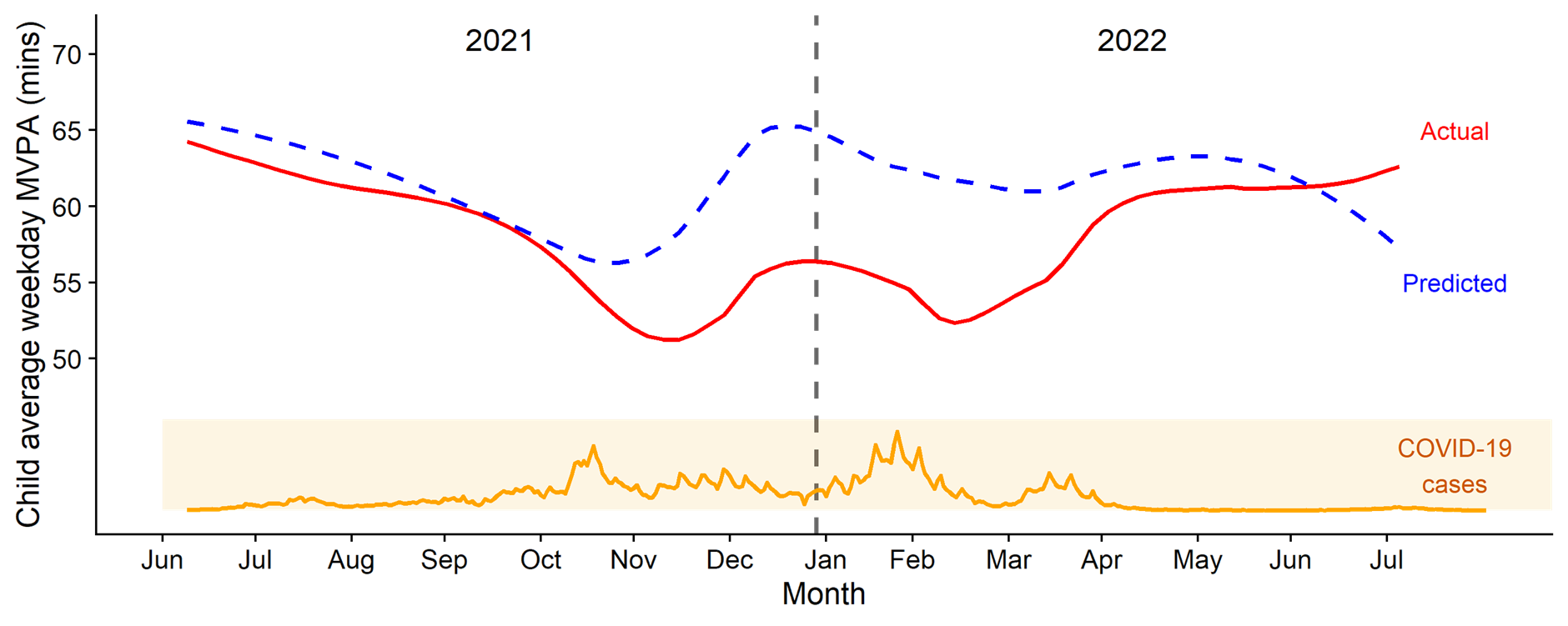Supporting children’s physical activity beyond the COVID-19 pandemic

Physical activity is central to the future health of the nation and preventative healthcare strategies. Active children are more likely to become active adults, and childhood is a key period for developing physical skills and confidence.
About the research
The UK Chief Medical Officers recommend that all children and young people should do at least an hour of moderate to vigorous intensity physical activity (MVPA) per day. This is activity that gets children slightly hot, slightly sweaty, and slightly out of breath. Data from before the COVID-19 pandemic show only 41% of 10–11-year-old children met these guidelines.
Between 2020 and 2021, lockdowns and restrictions to reduce the spread of COVID-19 affected children’s opportunities to be active. We aimed to assess the impact of the pandemic lockdowns on children’s physical activity and suggest ways to help more children to be active.
We measured the physical activity levels of around 400 children with accelerometers – devices that measure MVPA – at two time points: in 2021 and 2022. This gave us an idea of the shorter- and medium-term impact of the lockdowns on child activity levels. We compared these data with information measured in the same way in 2017/18, before the pandemic.
We also spoke to parents, children, and school staff about their experiences. This combination of data sources gives a robust picture of how child physical activity has changed.
A year after all COVID-19 restrictions were lifted average child MVPA had recovered, but sedentary time remained high and there is a ‘new normal’ for child physical activity.
These changes have affected girls and children from lower income households greatest. Policies are urgently needed to support all children to be active, with targeted support to these groups.
Policy recommendations
- Policy and programmes to support children’s physical activity must be sensitive to the ‘new normal’ for child activity, which relies on organised activities such as clubs, with particular demand for convenient and affordable school-based clubs.
- Primary schools need additional resources to provide a wide range of active clubs for all abilities.
- Targeted support is needed for girls and children/ schools from more disadvantaged communities, whose physical activity was more adversely affected by the lockdown.
- There is a need to build on current initiatives to maximise the use of school facilities outside of school hours to cost-effectively increase children’s physical activity at scale.
- Community and sports organisations need financial support to deliver convenient and affordable community-based clubs that all families can access.
Key findings
- It took a year of no restrictions for children’s physical activity, on average, to recover to pre-pandemic levels.
- Despite a recovery on average, still only 41% of children meet physical activity guidelines.
- The recovery may be precarious, and some groups have been more adversely impacted, particularly families from lower socio-economic groups, children who were already less active, and girls, exacerbating inequalities from before the pandemic.
- Despite average physical activity recovering, children’s sedentary time remains higher than pre-COVID-19 by almost 15 minutes per weekday.
- There is a ‘new normal’ for post-pandemic child physical activity behaviour, with a greater dependence on organised activities, such as active clubs.
- The reliance on organised activities, and the rising costs of these, has led to increased inequalities and more demand for school-based activities that many schools are struggling to meet. The cost-of-living crisis has further impacted on these changes, as clubs become a luxury that many are unable to afford.
Children’s physical activity varied over the study. Most of the time it was lower than what we would have expected based on pre-pandemic data. Drops in MVPA coincide with increased COVID-19 cases. Graph from Jago et al, 2023.

Further information
Key publications are below with all papers and resources on the Active-6 hub.
Jago et al. Short and medium-term effects of the COVID-19 lockdowns on child and parent accelerometer-measured physical activity and sedentary time: a natural experiment. Int J Behav Nutr Phys Act 20, 42 (2023).
Walker et al. The new normal for children’s physical activity and screen viewing: A multi-perspective qualitative analysis of behaviours a year after the COVID-19 lockdowns in the UK. BMC Public Health 23, 1432 (2023a).
Walker et al. The status of active after-school clubs among primary school children in England (UK) after the COVD-19 lockdowns: implications for policy and practice. Int J Behav Nutr Phys Act (2023b).
Contact the researchers
Russ Jago, Professor of Physical Activity and Public Health
University of Bristol Russ.Jago@bristol.ac.uk
PolicyBriefing 139: Sept 2023.
Briefing 139 Jago Supporting children’s physical activity beyond COVID-19 (PDF, 1,599kB)
Authors
Prof. Russ Jago, Dr Danielle House, Dr Ruth Salway, and Dr Robert Walker, University of Bristol